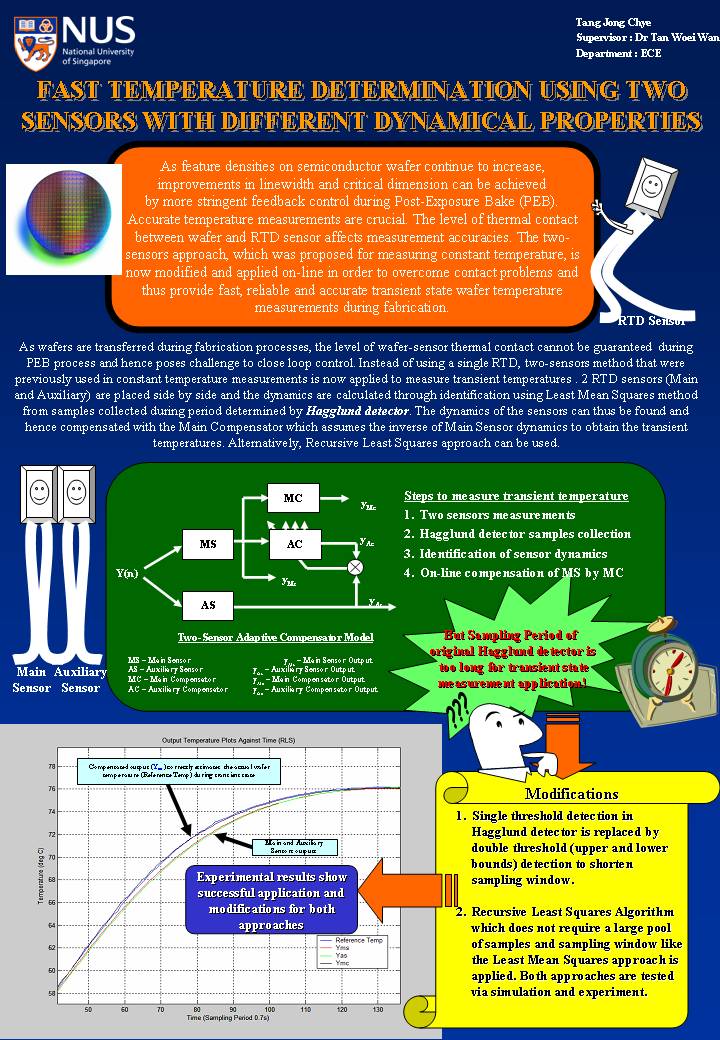| EE4001 Projects (Academic Year 05/06) | |
|
|
Analysis of Type-2 Fuzzy System |
|
|
Adaptive Control Using a RRBF Neural Network |
|
|
Fault Tolerant Control Using Elman Network |
|
|
A Fuzzy Classifier for Breast Cancer Diagnosis |
|
|
Closed-loop control of Electrostatic Micro Mirror |
| Analysis of Type-2 Fuzzy System | |
|
A type-2 fuzzy logic system (FLS) is an entity that characterizes its input or output domains with one or more type-2 fuzzy sets. Type-2 fuzzy sets, an extension of type-1 fuzzy sets, model the uncertainty in the membership grade of an element in the set by a concept known as the footprint of uncertainty (FOU). The FOU provides an extra degree of freedom, thereby enabling it to model a more complex input-output relationship compared to a FLS that utilises the same number of type-1 fuzzy sets. However, it is not clear how the extra mathematical dimension associated with FOU enables a type-2 FLS to differentiate itself from a type-1 FLS. This project will first re-produce the input-output relationship of the type-2 FLS using a group of equivalent type-1 sets (ET1Ss). A better understanding of type-2 FLS can then be obtained by analysing the characteristics of the ET1Ss. |
|
| Adaptive Control Using a RRBF Neural Network | |
|
Many methodologies that have been proposed for controlling non-linear plants employ either a fuzzy system, neural network or a neurofuzzy model. A common strategy is to train a fuzzy/neural system to model the inverse plant dynamics and use it as a feedforward controller. A self-learning control scheme consisting of a feedforward neurofuzzy model, that is trained on-line to approximate the characteristics of the plant, and a proportional controller that acts as a feedback trimmer for unmeasured disturbance have been successfully used to control simple processes. A problem with the self-learning neurofuzzy controller is that a neurofuzzy system suffers from the curse of dimensionality so it is difficult to build a neurofuzzy model for a high order system. A recurrent network is more suited for dynamic system identification. This project aims at assessing the feasibility of replacing the neurofuzzy model in the self-learning control scheme by the recurrent radial basis function (RRBF) neural network. |
|
| Fault Tolerant Control Using Elman Network | |
|
A conventional feedback control loop may result in unsatisfactory performance, or even instability, in the event of malfunctions in actuators, sensors or other components of the system. With the increasing demand for safer and more reliable dynamical systems, new controllers which are capable of tolerating component failures while maintaining desirable performance are being developed. One approach is to detect faults in control systems and reconfigure the control system when faults occur. This is considered a better approach than attempting to increase robustness to cope with fault conditions, due to the penalty in performance. This project aims at using an Elman Network (a type of recurrent neural network) to develop a fault tolerant controller. |
|
| A Fuzzy Classifer for Breast Cancer Diagnosis | |
|
Mammography is the most readily available modality for the early detection of breast cancer. Clinical success of mammography is due to its high sensitivity to malignant lesions combined with cost-effectiveness. The high sensitivity of screening mammography is compromised by its low specificity to benign lesions which often appear mammographically similar to malignant lesions. This results in approximately 70% of biopsies performed on benign lesions. The negative effects of potentially unnecessary biopsies include pain, anxiety, altered cosmetic appearance and monetary cost. Biopsy can also introduce distortion on future mammograms, which could complicate diagnosis in the future. The purpose of this project is to use fuzzy theory to develop a diagnosis algorithm for improving classification of mammographic masses. |
|
| Closed-loop control of Electrostatic Micro Mirror | |
|
Micro-mirrors are mirrors that have been "shrunk" down to the microscopic world. They can be used in a variety of applications including: optical switching in fiber optic networks, maskless Extreme Ultra Violet (EUV) lithography, adaptive optics, and projection display devices. For telecommunications and EUV lithography applications, micromirrors will need to have 2 Degrees-of-Freedom (2-DOF) and be actuated to extremely precise positions. Micromirror prototypes that have been publicized at present do not include advanced control or features to guarantee that these precision requirements will be satisfied. The purpose of this project is to develop a feedback control system for manipulating the position of electrostatic micro mirrors. |
|
| Past Year Projects |
| Click on poster for details |

